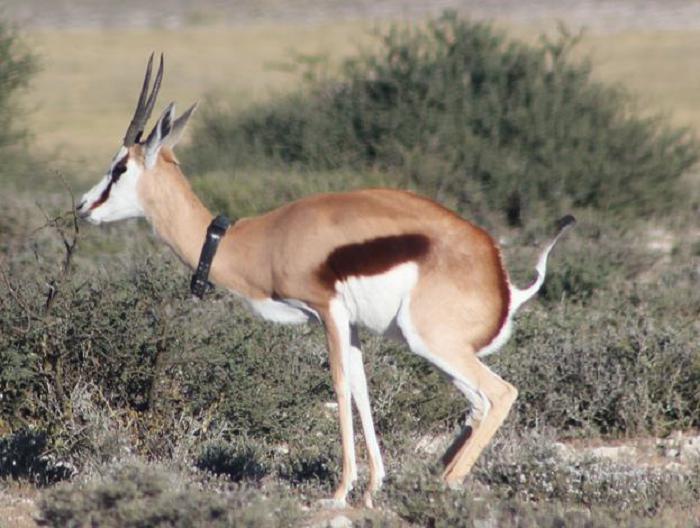Tshepo Moatswi
Aerial surveys over the last two decades have shown that springbok populations in Botswana are declining. We will investigate factors contributing to this decline in the southern Kalahari of Botswana leading to applied conservation activities aimed at halting, and ideally reversing, the observed population decline.
The following specific objectives will guide the study:
- To study recruitment rate of springbok population in different seasons.
We will use direct observation to record recruitment data. Recording age and gender of each animal.
- To study seasonal patterns of habitat selection.
We will deploy satellite collars to determine seasonal movement and habitat use by the springbok. We will plot springbok movement using ArcGIS (ESRI, Redlands, CA) software and develop a habitat map.
- To determine seasonal diet of springbok.
We will identify and sample grass and other plant species consumed by springbok in different seasons.

One of the collared springboks in the Kalahari Transfrontier Park.
A nationwide aerial census of Botswana conducted by the Department of Wildlife and National Parks (DWNP 2012) estimated a 71% decline in the springbok population between 1992 and 2012, while the nationwide range also contracted. Further research is required to understand the reasons behind this trend and recommend appropriate management responses. Most of the springbok population in Botswana inhabits the Kgalagadi region, within the Kgalagadi Transfrontier Park and the surrounding Wildlife Management Areas. However, the population declined across all protected areas, including in the Central Kalahari Game Reserve (DWNP, 2012). We will investigate possible factors contributing to the population decline in the southern Kalahari of Botswana by studying seasonal recruitment rates, habitat selection, and diet, leading to applied actions aimed at conserving the springbok population of Botswana. To our knowledge, very little research has been conducted on springbok ecology, and no studies have utilised GPS-enabled collars to research spatial ecology. We will use our results to inform policy and management decisions aimed towards conservation of this iconic species.
We will increase understanding of springbok ecology within the Kalahari system through detailed analysis of their resource requirements and space use. The DWNP has identified this as a priority study to inform actions aimed at stopping springbok population declines, therefore the results will be relevant to national conservation priorities.
Our study will be conducted in collaboration with the research division of the DWNP, thereby enabling dissemination of information directly to the DWNP. The research will also contribute to an MPhil thesis for a Botswana citizen. All findings will be shared with relevant non-governmental organisations and other authorities. Some articles will be published in popular magazines to reach and educate the general public. Our findings will also be shared with community education teams to provide outreach to communities around the country.
The DWNP has outlined the work as a priority study to stop springbok populations from declining, therefore the results will be relevant to national conservation priorities. The information provided by the study will form the scientific basis for more practical conservation outputs in the form of government policies directed at recovering springbok populations in Botswana. The study will also help develop local capacity by educating a local citizen to MSc level as a wildlife scientist and conservationist.